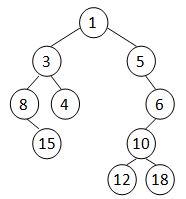A Cartesian tree is a binary tree constructed from a sequence of distinct numbers. The tree is heap-ordered, and an inorder traversal returns the original sequence. For example, given the sequence { 8, 15, 3, 4, 1, 5, 12, 10, 18, 6 }, the min-heap Cartesian tree is shown by the figure.

Your job is to output the level-order traversal sequence of the min-heap Cartesian tree.
Input Specification:
Each input file contains one test case. Each case starts from giving a positive integer N (≤30), and then N distinct numbers in the next line, separated by a space. All the numbers are in the range of int.
Output Specification:
For each test case, print in a line the level-order traversal sequence of the min-heap Cartesian tree. All the numbers in a line must be separated by exactly one space, and there must be no extra space at the beginning or the end of the line.
Sample Input:
10
8 15 3 4 1 5 12 10 18 6
Sample Output:
1 3 5 8 4 6 15 10 12 18
思路&分析
给出了一组树的inorder traversal中序遍历结果,用最小堆的形式建树。因为中序遍历根节点在中间,最小堆的根节点最小,那么每次从序列中找到最小值就是根,左半部分为左子树,右半部分为右子树,递归建树即可。最后根据题目要求用队列输出层次遍历结果。
注意点:
感觉没什么注意点…虽然是最后一题,但确是通过率最高的一题(通过率与分值成正比 :smile)建树基本功。
提交代码(AC)
#include <iostream>
#include <stdio.h>
#include <vector>
#include <queue>
#include <string>
#







 最低0.47元/天 解锁文章
最低0.47元/天 解锁文章















 343
343











 被折叠的 条评论
为什么被折叠?
被折叠的 条评论
为什么被折叠?








